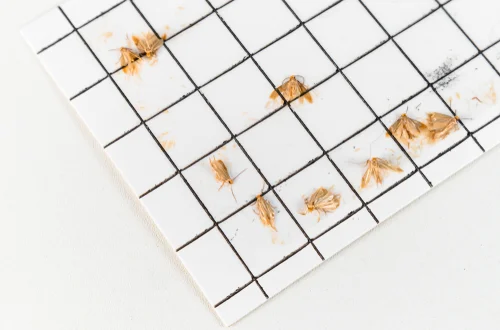Moth infestations can be a massive inconvenience. Thus, when you discover your favourite clothes or pantry staples destroyed by these little pests, it’s both distressing and frustrating. But don’t fret because there are effective steps for Moths exterminator. First, let’s analyze the enemy and understand their strengths and weaknesses.
1. Understanding Moths: The First Step
Before calling a Moths exterminator, it’s vital to know your enemy. So, let’s understand the different types of moths that you’ll encounter on your quest to eradicate them from your home.
a. Clothes Moths
These moths are the bane of wardrobes. Their preference? Organic fabrics like wool and silk. But they’re not picky and can target other materials if they’re dirty or moist. So, it’s important to get wool moths pest control.
b. Pantry Moths
As the name suggests, these moths raid your food stock, be it grains, dried fruits, or your pet’s food. Thus, food moths removal is very important
2. Cleanliness: The Foundation of Moth Prevention
Maintaining a clean environment is important before calling a Moths exterminator.
a. Vacuuming
Don’t underestimate the power of vacuuming. Aim for once a week, but if you can do it more frequently, even better. Ensure you reach all those corners and crevices.
b. Dust Regularly
Moths thrive in dusty areas. Regular dusting, especially in storage spaces, can make a significant difference.
c. Laundry Habits
Always clean clothes before storing them. Moths are particularly attracted to soiled clothing. Also, occasionally air out stored clothes on a sunny day. Moths despise sunlight and heat.
3. Storage Solutions: Your Defensive Wall
Correctly storing items can deter moths from making themselves at home.
a. Airtight Containers
When storing food, always choose airtight containers. Not only do they keep moths out, but they also maintain the freshness of your food.
b. Sealed Bags For Clothing
Vacuum-sealed bags are fantastic for clothes, especially those you store for longer periods, like winter clothing during summer.
c. Cool and Dry Environments
Both clothes and pantry moths thrive in humid environments. Ensure that your storage areas are cool and dry. Consider investing in dehumidifiers if you live in particularly humid regions.
4. Natural Moth Repellents: Mother Nature’s Gift
Nature has blessed us with several items that act as moth repellents.
a. Lavender
Apart from cedarwood, lavender is another scent moths can’t stand. Place lavender sachets in your wardrobe and pantry.
b. Bay Leaves & Cloves
Both are excellent moth deterrents. Scatter some in your pantry and watch them work their magic.
c. Peppermint Oil
A few drops on a cotton ball placed strategically in storage areas can be effective.
5. Monitoring: Your Early Detection System
Being proactive about checking for moths can save a lot of heartache.
a. Regular Inspections
Don’t wait for the damage to get worse. Rather, regularly inspect your storage areas, looking out for moth larvae or the moths themselves.
b. Pheromone Traps
These are especially useful for pantry moths. They attract and trap them, preventing them from multiplying.
6. When To Seek Professional Help
If preventive measures fail and you face a full-blown infestation, it’s time to bring in the experts.
a. Signs of Severe Infestation
If you’re constantly finding moths or your traps are filling up quickly, it indicates a bigger problem.
b. Safe Chemical Treatments
Professionals can provide targeted treatments that are both effective and safe for your home environment.
c. Regular Pest Control
Consider regular pest control visits if you live in an area with many moth infestations. Doing this is an investment that can save you money and stress in the long run.
7. Temperature Control: Moth’s Cold Reality
Moths love warmth, which accelerates their life cycle. Disrupting their ideal temperatures can help you keep them at bay.
a. Cold Storage
For particularly valuable clothing items, like fur or special woollens, cold storage is beneficial. Extreme cold can kill any eggs or larvae that might be on the clothing.
b. Freeze Your Fabrics
If you suspect an infestation in certain garments, seal them in plastic bags and freeze them for a few days. This method effectively kills moth larvae.
8. Understanding Moth Behavior: Predict and Prevent
The more you understand about how moths behave, the better equipped you’ll be to prevent them.
a. Moth Life Cycle
Moths have four stages in their life cycle: egg, larva (caterpillar), pupa, and adult. The damage primarily comes from the larvae, which consume fabrics and food.
b. Moths and Light
Moths are notorious for being attracted to light, but it’s a myth that all moths love light. Pantry moths, for example, prefer darkness. Knowing this can help in early detection.
In Conclusion
Moth infestations can be daunting, but with the right knowledge and preventive measures, they are entirely manageable. Regular cleaning, vigilant storage, and monitoring can make all the difference. And if all else fails, professional help is just a call away. Remember, the comfort of a moth-free home is worth the amount of effort you put in. So, equip yourself with these strategies and ensure that your belongings remain safe and intact.

